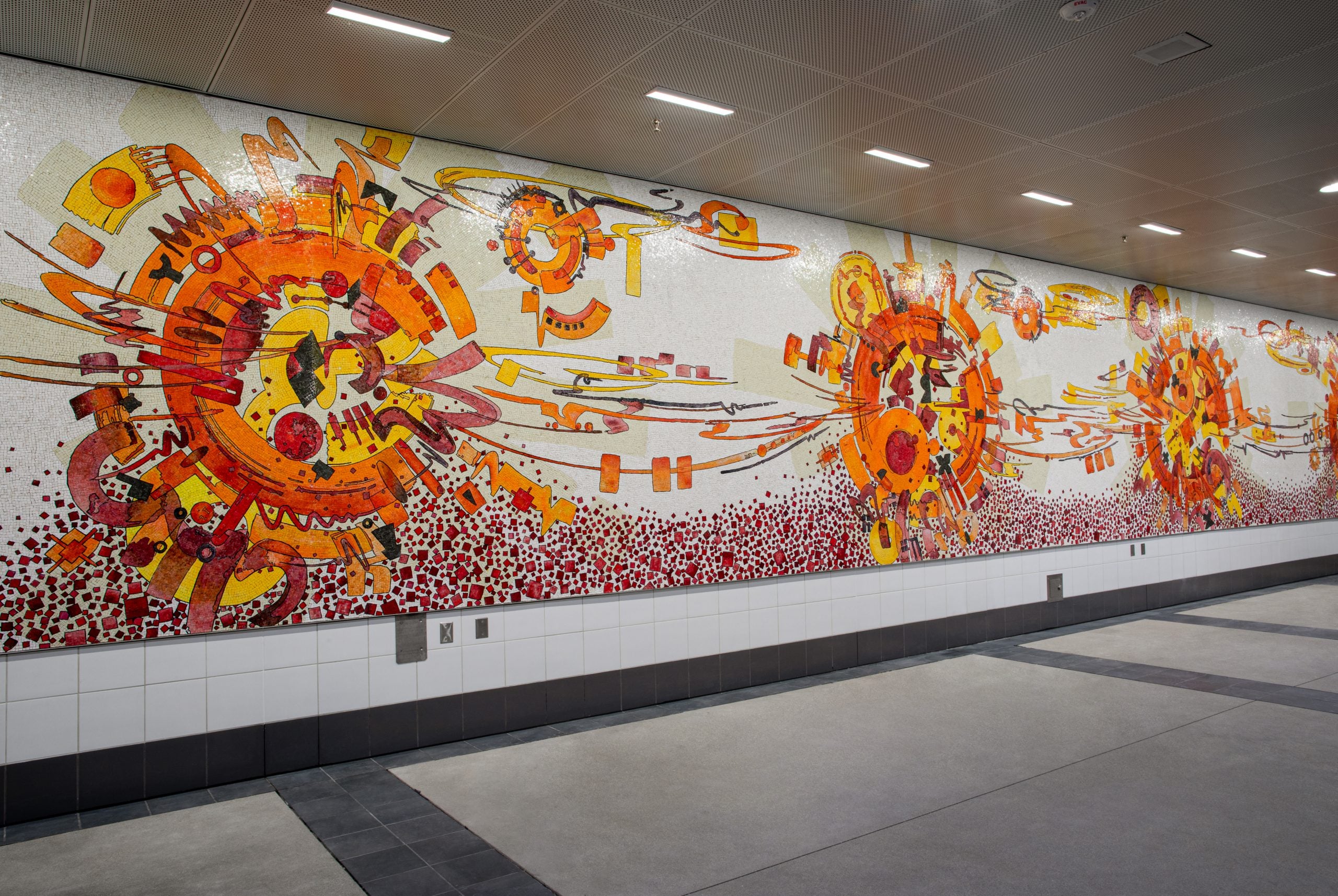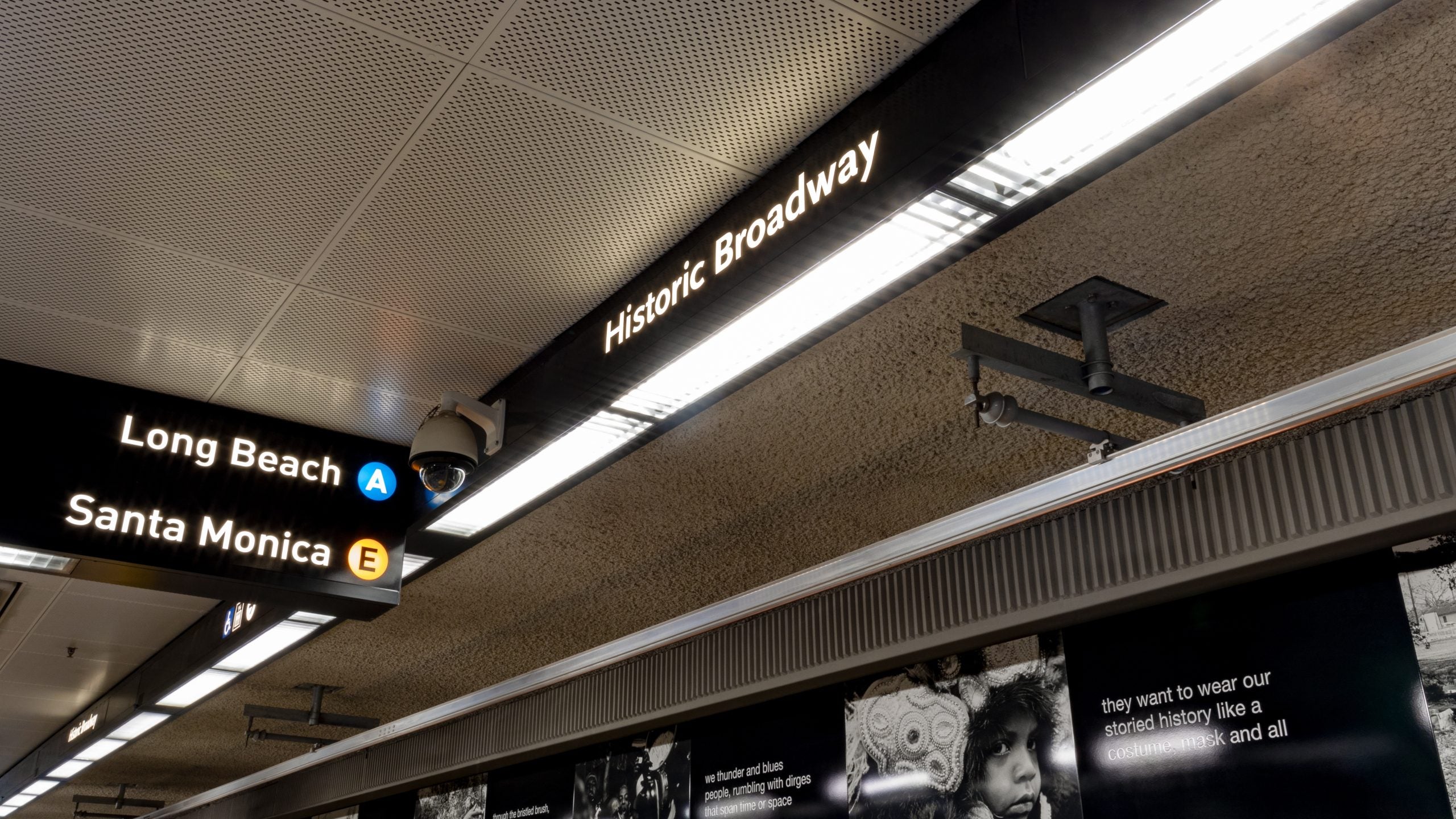
[ad_1]
As ever-expanding as Los Angeles is, its public transportation system hasn’t always kept up with its growth. The Los Angeles Metropolitan Transportation Authority (LA Metro) aims to change that, and is increasing awareness through the arts.
LA Metro taps heavily-awarded artists Mark Steven Greenfield and Clarence Williams to liven up one of its new Regional Connector sites, the Historic Broadway Station. While the artistic mediums differ, the foundational themes couldn’t be more aligned. Reverence, community, and the endless possibilities of life decorate the walls of the new Historic Broadway Station. Seated under the LA Times building, the station connects the Broadway theater and historic downtown districts of Los Angeles. The Regional Connector, which is the result of a longstanding effort to simplify LA’s public transportation system, was unveiled in June. It opens the lines of access for passengers to reach areas across LA County such as civic hubs, art centers, and beaches more efficiently. LA Metro is setting out to build a more accessible infrastructure complete with intentional art.

Greenfield is a born, raised, and educated Angelino with a clear appreciation for his city. His piece, “Red Car Requiem,” located in the station’s concourse, is an electrifying, warmly-colored mosaic paying homage to the Pacific Electric “red cars” that once populated the city and connected much of Southern California. As the city’s population and highways expanded, the red cars dwindled, leaving the beloved trollies to memory. Greenfield felt it important to highlight such a “seminal part of the city,” as the red cars contributed to LA’s “urban sprawl.” Prioritizing this communal history, Greenfield sought out older LA residents to share their red car experiences, “One person bought one of the cars when they were decommissioned, put it in his backyard and used it for family meals; my mother talked about how they used to take the red car down to the beach all the time. So many Black people would get on it, they called it the “Ubangi” line,” he laughs affectionately.
Greenfield’s locomotive tribute includes eight rosettes, signifying destinations along a route. Black idiosyncratic shapes inside each rosette reference the distinctive symbols train conductors would punch into passengers’ tickets. These details come together to tell an ongoing story of community and life. “I was looking at the idea of color as it relates to energy, as it relates to movement. What I’m hoping is that when somebody looks at [the artwork] they get that feeling of energy and movement,” he explains.
Greenfield gets candid when discussing his initial interest in the project, “Actually, I had a lot of disdain for public art. As an arts administrator I sat on panels for public projects and found [artists’] creative ideas compromised. Other artists I spoke with said their experiences with Metro had been very different and that there was a great deal of respect paid to the artists for being able to realize their vision.” LA Metro’s respect for this vision brought “Red Car Requiem” into fruition.

Williams is a Philly native who keeps finding himself drawn back to LA. Williams’ piece “Migrations,” located on the platform level, delves into the way he and many others came to Los Angeles. His photos, accompanied by thought-provoking haikus, depict moments of human life and expansion. One side of the platform portrays the story of Black migration and displacement through the context of the Hurricane Katrina catastrophe, which Williams was a survivor of. Living through this devastating, life-altering event influenced Williams’ approach to the project. He recalls, “the specific moment that made me question my citizenship was when the news kept referring to us as refugees, not IDPs [internally displaced persons]. To be a refugee, that means you’re not really a citizen.”
Williams’ work intimately expresses the ideas of belonging, migration by means of force or otherwise, and the new communities forged as a result. The opposite side of the platform displays images of diverse communities from natives of the land to global immigrants who now call Los Angeles home. “It’s so easy to have a view of what people think LA is, but it’s important to talk about these various, multicultural communities, especially our indigenous brothers and sisters,” he explains, “it’s important to keep in mind that this was not discovered land.” Utilizing the platform, Williams weaves together a story of collectivism, growing pains, and hope.
When asked about the meaning behind the coinciding haikus, Williams said, Ursula Rucker was the brilliant mastermind behind them. Rucker, an accomplished poet, activist, mother, and longtime collaborator of Williams explains that haiku writing is an artistic practice of love. The care Rucker and Williams have for each other, their work, and by extension all who come into contact with it, is what makes “Migrations” so powerful. Rucker contextualized the photos by centering the vulnerability of human connection and considering how the stories would resonate with the audience. She describes the connective energy art can create and how she actualized this through language. Her hope is for passengers to see these words and let them translate into compassion for each other.
With the platform granted by LA Metro, Greenfield, Williams, and Rucker have created worlds within the Historic Broadway Station that not only welcome metro-riders but also illuminate the new possibilities that await.
[ad_2]
Source link




